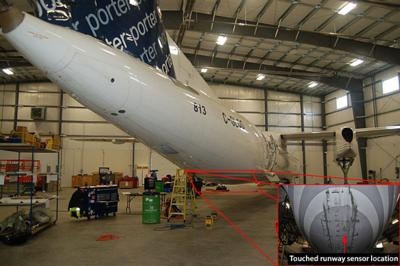Sat, Feb 14, 2015
No Injuries Reported In Incident Involving A Bombardier DHC-8-402
The Transportation Safety Board of Canada (TSB) has released its investigation report (A13O0098) into a May 2013 hard landing and tail strike involving a Porter Airlines Inc. aircraft at the Sault Ste. Marie Airport in Ontario. There were no injuries; however, there was substantial damage to the aircraft.

On 26 May 2013, a Porter Airlines Inc. Bombardier DHC-8-402 flew from the Billy Bishop Toronto City Airport to the Sault Ste. Marie Airport. At 2216 Eastern Daylight Time, during touchdown, the tail struck the runway. After landing, the aircraft taxied to the gate where the passengers were deplaned.
During the final approach to landing, the airspeed began to decrease and the descent rate began to increase. This profile put the aircraft in an unstabilized approach requiring a go-around, but the crew continued with the landing. As the aircraft rapidly approached the runway, instead of increasing engine power to reduce the rate of descent, the pilot pitched the nose up beyond the limits stated in the standard operating procedures and manufacturer's pitch awareness training. The investigation found that the high rate of descent coupled with the high nose-up attitude of the aircraft resulted in the hard landing compressing the struts and allowing the tail to contact the runway.
The investigation also drew attention to the need to clearly define the requirements for a stabilized visual approach, and to clearly define the duties of the pilot monitoring in order to mitigate the risk that unsafe flight conditions could develop.
Immediately following this occurrence, Porter Airlines Inc. initiated an internal investigation as part of its Safety Management System. Part of the immediate corrective action involved a revision of the Pitch Awareness Training highlighting previous occurrences and the need to arrest high descent rates with power and not pitch. The company also conducted a review of training for captains and pilots, reviewed use of flap settings on approach, provided further clarification on the stabilized approach procedure, and re-emphasized hazards associated with night-time operations.
Approach-and-landing accidents are a TSB Watchlist issue. The Board is calling on Transport Canada and operators to do more to reduce the number of unstable approaches that are continued to a landing.
(Image from TSB report)
More News
Its Offerings Are Lighter, Cleaner, and Now Pushing Past 1,000nm on SAF Jet Fuel DeltaHawk’s diesel-powered aircraft lineup has seen incredible upgrades over the last few yea>[...]
The Airplane Experienced A Total Loss Of Engine Power On December 3, 2025, about 1600 central standard time, a Mooney Aircraft Corp. M20K, N57229, was substantially damaged when it>[...]
Make Sure You NEVER Miss A New Story From Aero-News Network Do you ever feel like you never see posts from a certain person or page on Facebook or Instagram? Here’s how you c>[...]
Aero Linx: European Society of Aerospace Medicine (ESAM) As a pan-European, independent forum, it works to promote the safety and health of all persons involved in aviation and spa>[...]
“We are excited to see Wisk achieve this milestone, and I’m so proud of the team that made it possible. The team at Wisk has built advanced technologies across flight c>[...]
 Aero-TV: DeltaHawks Diesel Power Steps Into the Spotlight
Aero-TV: DeltaHawks Diesel Power Steps Into the Spotlight NTSB Prelim: Mooney Aircraft Corp. M20K
NTSB Prelim: Mooney Aircraft Corp. M20K ANN FAQ: Turn On Post Notifications
ANN FAQ: Turn On Post Notifications ANN's Daily Aero-Linx (12.20.25)
ANN's Daily Aero-Linx (12.20.25) Aero-News: Quote of the Day (12.20.25)
Aero-News: Quote of the Day (12.20.25)



